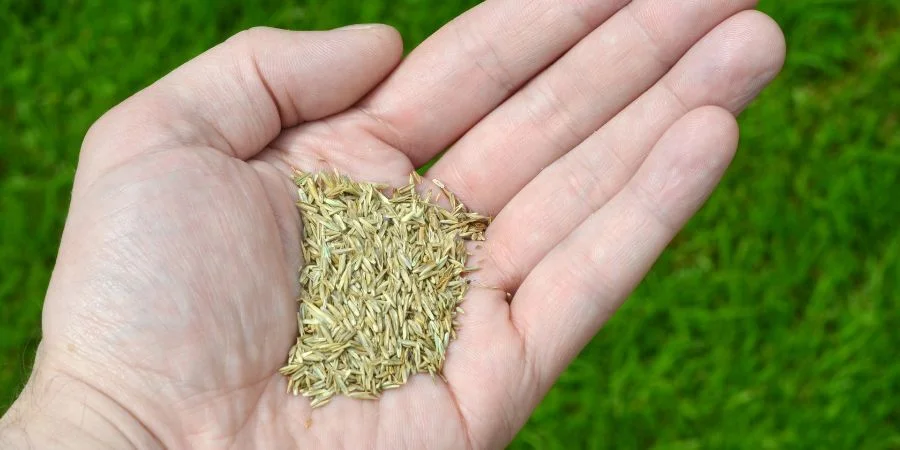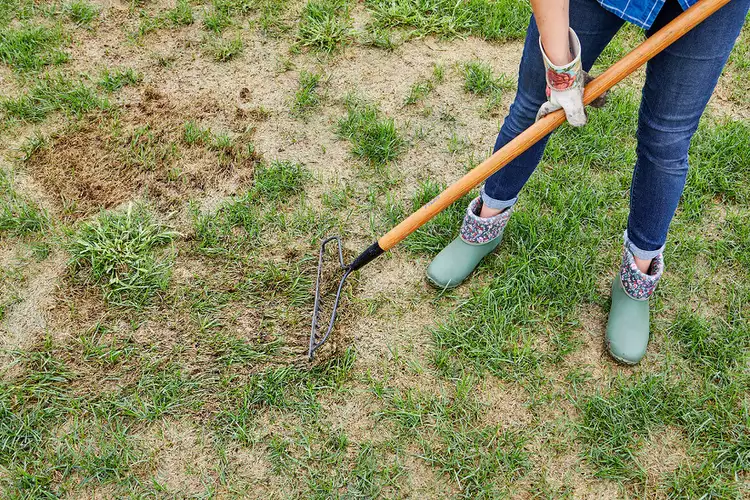Can I Mow Right After Aerating?
Last Updated on October 22, 2020 by Duncan
Aeration is an excellent way of keeping your lawn healthy and beautiful.
I remember this day like it was yesterday. It was a Friday, and I heard the aerator’s truck pull up at my backyard. I was confused.
While I had contacted them, I didn’t expect them to turn up too soon. I planned to aerate the lawn so that I could overseed it, but now they had showed up before I had mowed.
I couldn’t send them back as I would have been charged for a service I didn’t consume.
So, what did I do?
I came up with a plan and asked them, can I mow right after aerating? They looked at me, puzzled, and laughed.
You can seed, water, and fertilize your lawn right after aerating, but you shouldn’t mow.
This is because doing this will rob the soil of the benefits of aerating.
When you mow, the soil plugs will break down and cover the holes you made with the aerator, and as a result, air won’t get into the grassroots.
The grass/rocks/dirt clumps that result from aeration can also ruin your lawnmower blades.
To keep your lawn in perfect shape and take full advantage of aeration, be patient. After aerating and overseeding, give your lawn 2-4 weeks before mowing.
This way, you will have given the new grass time to acclimate and set roots.
After the new grass has germinated and is now 3-4 inches tall, now mow the lawn. When doing it, mow without the catcher on.
This is to break the soil cores back into the lawn, serving as a natural top dress.
What is lawn aeration?
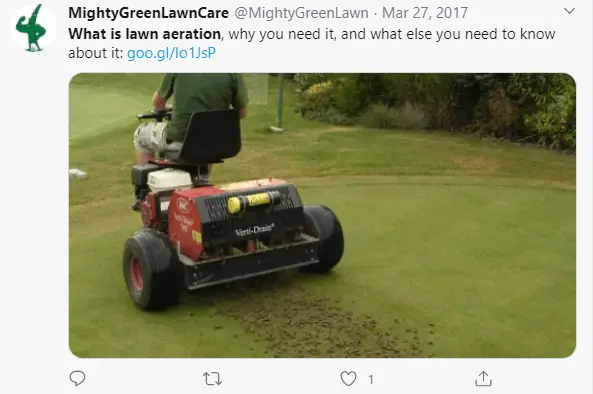
This is a common lawn maintenance procedure that should be done on any lawn, but it’s more beneficial to lawns that experience a lot of foot traffic.
As you can guess, when you have many people walking on your lawn, the soil becomes more compacted, which significantly reduces the spaces in the soil that can hold air.
This results in decreased airflow within the soil, which negatively affects root growth.
Lawn aeration involves removing soil plugs from the turf.
The resulting holes allow air, water, and nutrients to move through the soil, which increases the quality and health of the grass. The roots also get stronger; hence your grass can withstand harsh climates.
Other benefits of lawn aeration include:
- Better rainfall and irrigation absorption
- Development of a topsoil layer underneath the grass
- Inhibition of thatch accumulation
- Prevention of fertilizer and pesticide runoff
How do you know your lawn needs aeration?
To maintain a healthy, green lawn, you should aerate your lawn once or twice a year, depending on your grass type, soil, and amount of use.
If your lawn experiences heavy traffic, you should aerate it once a year. Also, aerate the lawn more often if your lawn has dense, clay soil.
You also should aerate your lawn if thatch on your lawn is more than one-half inch.
When the thatch on your lawn accumulates too much, new grassroots can’t penetrate the soil. Excessive thatch also makes your lawn more susceptible to pests and lawn diseases.
When to aerate your lawn
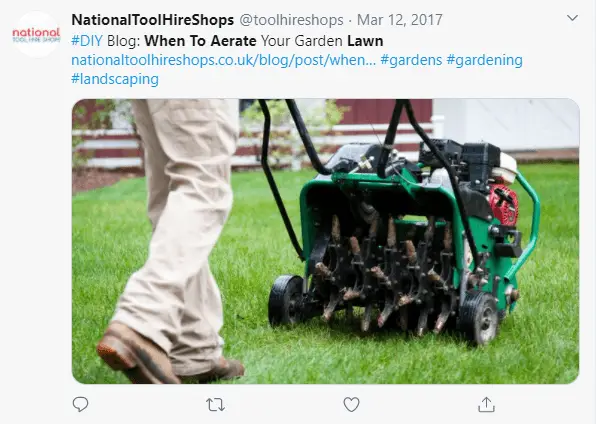
When you aerate the lawn will depend on the type of grass growing in your yard.
If growing cool-season grass (fescue, bluegrass, Kentucky), aerate in the spring before applying pesticides. You can also do it in the fall before overseeding.
If you have warm-season grass (Zoysia and Bermuda), aerate your lawn in the summer when the grass is growing.
Before aerating the lawn, water the area thoroughly (for at least 2 days) to make it easy for the aeration tines to penetrate the soil.
Don’t aerate immediately after an extended period of rainfall as the soil is too wet at this time; hence it will stick to the inside of the tines instead of falling back onto the lawn.
Lawn aeration tools
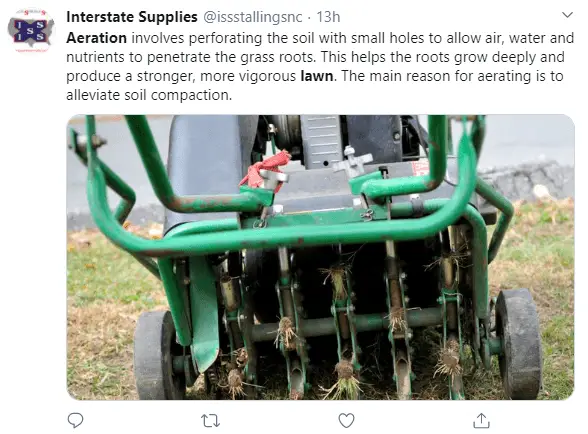
It’s always wise to hire lawn care professionals to aerate your lawn as they will aerate the lawn and help you analyze your soil type, grass health, and advice you on how to take good care of your grass.
Lawn care professionals also have the best lawn care tools and machines to get the work done fast and correctly.
The only drawback is they come at a fee. Sometimes, they are hard to come by, especially if you are hiring them during the peak season.
If you don’t have money to hire the professionals or you contacted them, and they are getting late, you should move and aerate the lawn by yourself. To do it, you need to have the right tools for the work.
Thankfully, you don’t have to buy these tools—you can hire them from your local landscaping store. Some of the aerating tools you need include:
Core aerators
Core aerators feature hollow tines that mechanically remove soil plugs or “cores” and thatch from the lawn.
Core aeration is the most effective form of aerating the lawn as you create holes of significant diameter: ½ inch to ¾ inch that allows water, air, and nutrients to get into the grassroots.
If you are looking to seed your lawn, you are advised to undertake core aeration.
For best results, ensure the plug aerator tines make holes between one and six inches deep.
Slice aerators
From their name, slice aerators make a simple slice into the turf. The aerators have rotating blades that cut through the grass and thatch.
While they don’t take any soil from the ground, they leave areas where water, air, and nutrients can easily get into the soil.
Spike aerator
Spike aerators have sharp tines that push the soil down to the sides, making holes that make the soil loose.
Like slice aerators, these tools don’t remove any soil from the ground. Instead, they poke holes in the ground, getting rid of compaction.
These aerators come in different sizes, with some aerators being curved and providing deep penetration (up to 9 inches).
While spike aeration works in the short term, it doesn’t provide long term results.
Since the spike aerators push the soil down to the sides instead of removing the thick thatch that is often the cause of compaction, the results last for a short time as the soil readjust, closing the small holes a few days later.
Since you don’t remove soil plugs, the spikes’ holes don’t reduce core compaction. Instead, they increase compaction deep in the ground.
Immediately after aeration, your lawn is ripe for overseeding and fertilizing. The holes provide excellent soil exposure for seeds and also help in delivering fertilizer directly to the grassroots.
For best results and an easy time, mix high-quality grass seed with high-quality fertilizer such as Milorganite.
Can you aerate your lawn too much?
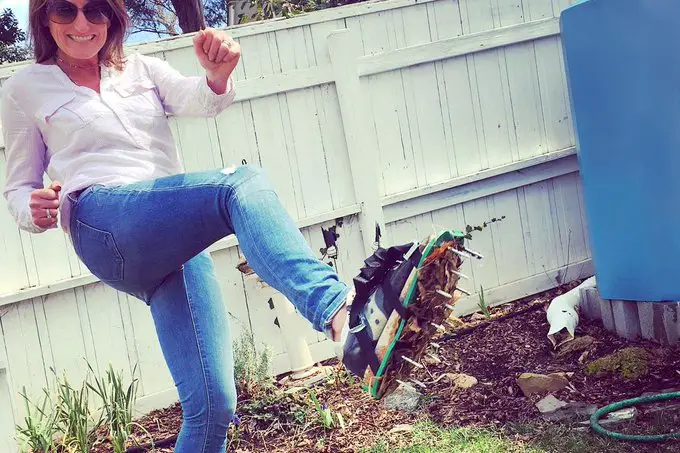
Yes, you can when you aerate your lawn too often than is necessary. At workhabor, we recommend you aerate your lawn once a year unless you have clay soil known to cause compaction problems. If this is your case, aerate your lawn two times a year.
You also should aerate your lawn more often if you have thick and full grass such as Bermuda grass.
Such grasses tend to form thick layers of thatch too fast, especially when you don’t dethatch regularly.
Should I pick up plugs after aerating?
When you use a core aerator, you will have plugs on your lawn.
The plugs are a thick mass of decomposing thatch and often give your lawn a dirty look. If you are a perfectionist, you might be tempted to pick them up.
Don’t do it as it’s not only tiring but also unnecessary. Leave the plugs on your lawn to decompose and release the soil’s nutrients and feed the grass.
If you don’t like how they look, collect them using a rake and add them to your compost. Once they have decomposed, use them for topdressing or for growing new sod.
Don’t mow your lawn after aerating.
You shouldn’t mow your lawn after aerating as you will cover the holes you worked hard to create.
In fact, it’s recommended you stay away from your lawn after aerating to give the newly planted grass time to grow.
For your grass to recover fast, aerate your lawn when the grass is actively growing. Avoid aerating a dormant lawn.
